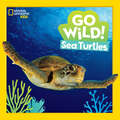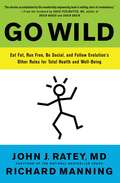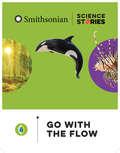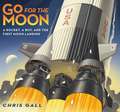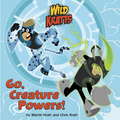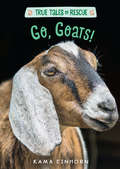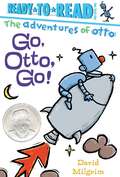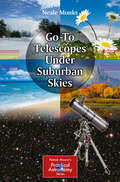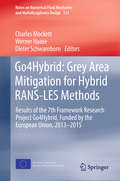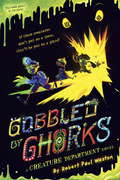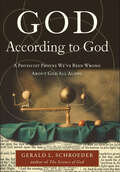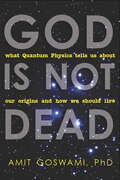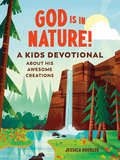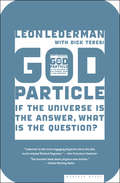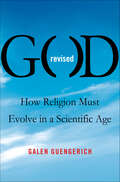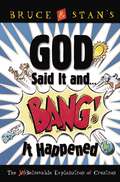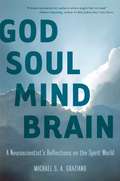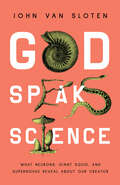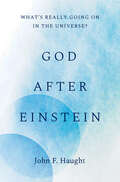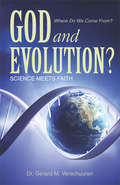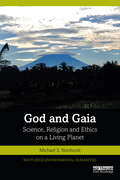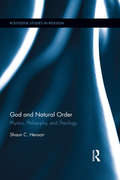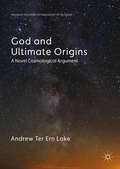- Table View
- List View
Go Wild! Sea Turtles (Go Wild!)
by Jill EsbaumWelcome to the wild world of sea turtles! In this intro to the species, youngsters discover where on Earth this reptile lives, what it eats, and how big it grows. Cool photos of all the different kinds of sea turtles and adorable photos of just-hatched turtle babies bring the creatures into full focus. After learning the basics, young readers will learn why sea turtles need our help and what people around the world are doing to help save them. Filled with fun facts, games, and an activity focused on making a difference in sea turtles' world, Go Wild! will inspire kids to care about this swimmingly cute animal.
Go Wild: Free Your Body and Mind from the Afflictions of Civilization
by John J. Ratey Richard Manning David PerlmutterThe scientific evidence behind why maintaining a lifestyle more like that of our ancestors will restore our health and well-being. In GO WILD, Harvard Medical School Professor John Ratey, MD, and journalist Richard Manning reveal that although civilization has rapidly evolved, our bodies have not kept pace. This mismatch affects every area of our lives, from our general physical health to our emotional wellbeing. Investigating the power of living according to our genes in the areas of diet, exercise, sleep, nature, mindfulness and more, GO WILD examines how tapping into our core DNA combats modern disease and psychological afflictions, from Autism and Depression to Diabetes and Heart Disease. By focusing on the ways of the past, it is possible to secure a healthier and happier future, and GO WILD will show you how.
Go for the Moon: A Rocket, a Boy, and the First Moon Landing
by Chris GallWritten and illustrated by Chris Gall, Go for the Moon! captures the fascinating detail and inspiring adventure of the moon landing. It is a captivating celebration of one of humankind's greatest technical achievements and most extraordinary feats of exploration.The Apollo 11 astronauts have prepared carefully for their attempt to be the first men to land on the moon. The young narrator of this book has prepared carefully, too: he explains the design of the spacecraft, the flight from the earth to the moon, and the drama of touching down--while shadowing the astronaut's voyage with one of his own.
Go, Creature Powers! (Pictureback(R))
by Random House Chris Kratt Martin KrattPBS's hit animated show Wild Kratts follows the adventures of zoologists Chris and Martin Kratt as the duo visits animal habitats around the globe. Along the way, they encounter incredible creatures while combining science education with fun. Boys and girls 4 to 6 will learn everything there is to know about the Wild Kratts' amazing Creature Power suits!
Go, Goats! (True Tales of Rescue)
by Kama EinhornPart of a photo-packed series exploring the stories and science behind animal sanctuaries, Go, Goats! delivers an up-close look at what life is like at a farm sanctuary in upstate New York, straight from a goat herself. A nonfiction chapter book for elementary-age readers, it includes full-color photos, graphics, and maps. It&’s summertime in upstate New York and the Camp Kindness volunteers have arrived at Catskills Animal Sanctuary. Wise old goat Lucia knows everything about the farm sanctuary and its residents—from the weeping willow tree with the best leaves to nibble on, to which goats are snugglers and which like their space, to the differences between goats and sheep (note: there are many—start with the eyes!). Lucia is a member of what the farm staff calls the Underfoot Family. It&’s a group of more than fifty animals—goat, sheep, chickens, ducks, and even a pig—who have free reign of the farm. While the staff works hard to rescue, recover, rehabilitate and release all of the farm animals who come to the sanctuary, not every animal will leave—Lucia is one who will spend the rest of her days in the comfort of the sanctuary, watching babies be born and new friends come and go, and welcoming a new group of campers every summer with a warm heart and a gentle head butt. What is life like at Catskills Animal Sanctuary? Lucia will tell you everything!
Go, Otto, Go!: Ready-to-read Pre-level 1 (The\adventures Of Otto Ser.)
by David MilgrimOtto the robot builds a spaceship to take him home.
Go-To Telescopes Under Suburban Skies
by Neale MonksGo-To Telescopes Under Suburban Skies is the first book specifically written for amateur astronomers who own, or who are about to purchase, a computer-controlled 'go-to' telescope. The advantage of the 'go-to' capability is enormous - the telescope can be aimed at any object in the sky with great speed and accuracy - which is why these instruments are so popular. Making the realistic assumption that the observer is using a relatively small telescope and is observing from a backyard in a suburban area, this book provides literally hundreds more targets beyond those offered by the built-in 'nightly tours' that feature on the telescope's computer tours. And instead of wasting many pages on maps and coordinates, it leads the computer to locate the targets, and so has room to suggest many more fascinating deep-sky objects and provide detailed observing lists and information about what's being viewed.
Go4Hybrid: Grey Area Mitigation for Hybrid RANS-LES Methods
by Werner Haase Dieter Schwamborn Charles MockettThis book reports on the EU-funded 7th Framework project, Go4Hybrid (Grey Area Mitigation for Hybrid RANS-LES Methods). It presents new findings concerning the accuracy and reliability of current hybrid RANS-LES methods. It describes improved formulations of both non-zonal and embedded hybrid strategies, together with their validation in a broad range of flow cases, and highlighting some key industrial applications. The book provides students, researchers and professionals in the field of applied computational fluid dynamics with a timely, practice-oriented reference guide.
Gobble It Up!: A Fun Song About Eating!
by Jim ArnoskyIf you were a wild. raccoon, You'd hunt at night by the light of the moon. You'd catch some crawdads where they crawl, And gobble them up -- shells and all! It's suppertime in the wild--and the animals are hungry! Clap your hands and sing along with renowned wildlife artist and folk musician Jim Arnosky in this catchy, factual picture book/song that follows animals as they engage in everyone's favorite daily activity--eating!
Gobbled by Ghorks
by Robert Paul Weston FramestoreIF THESE CREATURES DON'T PUT ON A SHOW, THEY'LL BE PUT ON A PLATE! When a singing telegram arrives with some seriously stomach-churning news, the Creature Department is once again thrown into an invention frenzy. Rumor has it that monstrous ghorks have taken the creatures of Heppleworth's Food Factory hostage. And worse, they are threatening to turn them into tasty treats!The Creature Department and their human friends, Elliot and Leslie, sneak into Heppleworth's disguised as performers in an all-singing, all-dancing dinner-theater cabaret. There they discover the five types of ghorks that had previously caused them a whole lot of trouble: nose ghorks, eye ghorks, ear ghorks, mouth ghorks, and hand ghorks--one for each of the five senses. But then they stumble upon something else: a sixth ghork, equipped with a mysterious sixth sense!When the sixth ghork's sixth sense is finally revealed, it is even more outlandish than anyone imagined; and the only way to save the day is to make a dangerous deal. But if the deal goes wrong, Elliot, Leslie, and every last creature will be... gobbled by ghorks!Praise for The Creature Department: "Stunning. . . . a bit like if you took Charlie and the Chocolate Factory and Monsters Inc. and shoved them in a TARDIS."--Buzzfeed"The creatures are a giggle-inducing example of an imagination run wild."--Associated Press
God According to God: A Physicist Proves We've Been Wrong About God All Along
by Gerald L. SchroederThis “brilliant” book by an M.I.T. trained physicist “demands the attention of anyone who wonders if God must be exiled from the modern, enlightened mind” (David J. Wolpe, author of Why Faith Matters).In his first book since 2002’s acclaimed The Hidden Face of God, popular scientist Gerald Schroeder combines decades of scientific research and biblical study to present a groundbreaking new theory of how to understand God. With riveting chapters on the origins of life, a scientist’s view of creation, and the unique place of our planet in the galaxy, God According to God offers a radical paradigm shift that will forever change how we comprehend God.“This is as important a book on this subject as I recall ever having read.” —Huston Smith, author of The World’s Religions
God Is Not Dead: What Quantum Physics Tells Us About Our Origins and How We Should Live
by Amit GoswamiA “pioneering” physicist “shows how quantum reasoning may resolve deep mysteries, including the nature of God [and] evolution” (Beverly Rubik, PhD, Biophysicist, Institute for Frontier Science, Adjunct Professor, Saybrook).Move over, Richard Dawkins and Christopher Hitchens—a highly regarded nuclear physicist enters the debate about the existence of God—and comes down on the side of the angels. Goswami’s hypothesis is that quantum physics holds the key to all the unsolved mysteries of biology—the nature and origin of life, fossil gaps of evolution, why evolution proceeds from simple to complex, and why biological beings have feeling and consciousness.In God is Not Dead, Goswami moves beyond theory and shows how a God-based science puts ethics and values where it belongs: at the center of our lives and societies. He provides a scientific model that steers between scientific materialism and religious fundamentalism; a model that has implications for how we live both individually and collectively.God is Not Dead is a fascinating tour of quantum physics, consciousness, and the existence and experience of God.
God Is in Nature!: A Kids Devotional About His Awesome Creations
by Jessica DoeblerThe only kids nature devotional featuring Scripture, Bible studies, and prayers that collectively teach children to praise God by appreciating nature and His awesome creations In this exciting and inspiring kids devotional, children will learn firsthand about God&’s fascinating world and amazing creations. From reading God&’s words in the Bible to getting outside and being captivated by the highest mountain and the tiniest fish, kids ages 6−10 will connect with God in fun and engaging ways. The Bible tells us about the story of creation and the amazing things that God can do. From rainbows and waterfalls to deserts and a starry night, God&’s miracles surround us, and they are undoubtedly awesome and cool. •100 kids devotions, organized by locale—accessible places like fields and parks; rivers, oceans, and lakes; and forests and mountains—offer opportunities for immediate exploration.•Prayers help kids slow down and appreciate what&’s in front of them.•Stunning illustrations capture a glimpse of the beauty and wonder that awaits the reader outside and creates the perfect gift package for those looking for a beautiful and meaningful Christian book for kids.•Less screen time with activity tips that encourage kids to get outside and see nature.
God Particle: If the Universe Is the Answer, What Is the Question?
by Dick Teresi Leon LedermanA Nobel Prize–winning physicist&’s &“funny, clever, entertaining&” account of the history of particle physics and the hunt for a Higgs boson (Library Journal). In this extraordinarily accessible and witty book, Leon Lederman—&“the most engaging physicist since the late, much-missed Richard Feynman&” (San Francisco Examiner)—offers a fascinating tour that takes us from the Greeks&’ earliest scientific observations through Einstein and beyond in an inspiring celebration of human curiosity. It ends with the quest for the Higgs boson, nicknamed the God Particle, which scientists hypothesize will help unlock the last secrets of the subatomic universe. This is not only an enlightening journey through baryons and hadrons and leptons and electrons—it also &“may be the funniest book about physics ever written&” (The Dallas Morning News). &“One of the clearest, most enjoyable new science books in years . . . explains the entire history of physics and cosmology. En route, you&’ll laugh so hard you won&’t realize how much you are learning.&” —San Francisco Examiner &“The story of the search for the ultimate constituents of matter has been told many times before, but never with more verve and wit. . . . His hilarious account of how he helped persuade President Reagan to approve the construction of the Super Collider is itself worth the price of the book.&” —Los Angeles Times
God Revised: How Religion Must Evolve in a Scientific Age
by Galen GuengerichOver the past few decades, the ever-expanding scientific knowledge of the universe and the human condition, combined with the evolution from religion-based to personal morality, has led to a mass crisis of faith. Leaders of most Protestant and Catholic religious traditions, which include nearly 80 percent of Americans, have watched their memberships stagnate or dwindle. Over the years, philosophers and scientists have argued that science has in fact "killed" God, and that if we believe the facts science has presented, we must also accept that God is fiction. Others, holding fast to their long-standing doctrines, attempt to justify their beliefs by using God to explain gaps in scientific knowledge. Having left an upbringing in a family of Mennonite preachers to discover his own experience of God, Galen Guengerich understands the modern American struggle to combine modern world views with outdated religious dogma. Drawing upon his own experiences, he proposes that just as humanity has had to evolve its conception of the universe to coincide with new scientific discoveries, we are long overdue in evolving our concept of God. Gone are the days of the magical, supernatural deity in the sky who visits wrath upon those who have not followed his word. Especially in a scientific age, we need an experience of a God we can believe in—an experience that grounds our morality, unites us in community, and engages us with a world that still holds more mystery than answers.
God Said It and Bang! It Happened: The UnBelievable Explanation of Creation
by Bruce Bickel Stan JantzIn this fun and entertaining look at the world and how we came to be, authors Stan Jantz and Bruce Bickel will answer the basic questions about life: Where did I come from? And why am I here? Filled with humor, this creative book is illustraed wiith line drawings from somewhat-crazy-himself autho/illustrator Bill Ross (Hey, That's Not What The Bible Says!) and includes chapters such as:Why Begin at the Beginning? What's the Big Deal about God? Long, Long Ago in a Galaxy Far Away Earth Wind and Fire The Matrix What if God was One of Us?I Want to Live Forever If Creation is True Why Isn't It in School?
God Soul Mind Brain
by Michael S. Graziano"Essential reading for the devout, the agnostic, and the atheist. In tackling the question of the religious brain, Graziano is respectful, sincere, and scientifically plausible. This might even be an Important Book."-Sam Wang, author of Welcome to Your Brain"A beautifully crafted, tightly scripted account of how the far-flung legions of the brain's neurons give rise to social awareness and our notions of soul, religion and God."-Christof Koch, author of The Quest for Consciousness"Lucid and engaging. . . . Moves with pace and humor."-Philip Johnson-Laird, author of Mental Models"Do we know the origins of Gods and ghosts? This well-written book makes the bold case that new discoveries in social neuroscience can illuminate human spiritual experience."-Terry Sejnowski, PhD, Salk Institute/UC San DiegoWriting for the general public, Michael S. A. Graziano explores the controversial relationship between science and religion, first dismissing the "science versus religion" debate as outdated. The cutting-edge field of social neuroscience explains how our perceptions of our own consciousness, of other minds, and of spirits and gods depend on machinery in the brain that evolved to make us socially intelligent animals. In clear prose without technical jargon, Graziano discusses his and others' findings in this twenty-year-old science and the implications for human spirituality and religion.Michael S. A. Graziano, professor of neuroscience, Princeton University, is the author of numerous articles on the functioning of the brain. He is internationally known for fundamental discoveries about sensory-motor coordination. His previous book on the brain, The Intelligent Movement Machine, was published by Oxford University Press in 2008.
God Speaks Science: What Neurons, Giant Squid, and Supernovae Reveal About Our Creator
by John Van SlotenA joy-filled expedition into experiencing God&’s majestic, everywhere presence.DNA, the Danube River, and deep-sea life. Knees and trees. The Swiss Alps, songbirds, and supernovas. God speaks though His creation. And you don&’t have to be naturally gifted at biology, chemistry, or physics to be awakened to His wisdom and majesty. Pastor, teacher, and non-scientist John Van Sloten invites us to know God more deeply as we marvel at the complexities of His amazing creation.Knowing God through His written Word enables us to know Him more clearly through His creational Words. How does God speak through His creation, and what is He saying? Each chapter includes interviews with leading scientists and connects creation to its Creator. With the primary foundation that Jesus is the mediator of both salvation and creation, Van Sloten fields questions such as:Why are things beautiful and how can beautiful things be engaged?How does the doctrine of the Trinity teach us about the nature of tree branches and wound healing?What do the doctrines of creation, incarnation, and the resurrection tell us about phenomenon of supernovas?How do we engage God&’s providence through knees and fossils?We were made to wonder. To marvel. To know and live in awe of God. God Speaks Science expands our hearts and minds so that we might delight in the wisdom, beauty, and awesome power of our triune God!
God after Einstein: What's Really Going On in the Universe?
by John F. HaughtA leading theologian presents a hopeful account of the universe after Einstein, exploring it as a meaningful drama of awakening&“This book is a deep and provocative piece of theology that proposes we engage with the universe as a kind of narrative of awakening and unfolding, as well as an important and useful approach for thinking about theology with respect to modern cosmology.&”—Matthew Stanley, New York University Before the early twentieth century, scientists and theologians knew almost nothing about time&’s enormity and the corresponding immensity of space. But now, after Einstein, cosmology offers theology a whole new way of looking at the ageless questions about matter, time, God, cosmic purpose, and the significance of our lives. The universe need not be thought of as simply an endless reshuffling of lifeless and mindless atoms in a pointless series of moments. Rather, the universe is a temporal drama of awakening whose meaning can be revealed only gradually by looking, in a spirit of anticipation and hope, toward the horizon of the cosmic future. In conversation with Einstein&’s ideas and opinions, John F. Haught develops here a new cosmological understanding of the meaning of God, time, eternity, mystery, life, thought, freedom, and faith. In doing so, he offers readers a new way of understanding the relationship of science to theology.
God and Evolution?
by Gerard M. Verschuuren Carlos A. SevillaWhere do we come from? Can a believing Christian accept evolutionary theory? What about? Intelligent Design? Are devout believers naïve and ill-equipped to take on current scientific debates? Can faith and science be reconciled? What does the Catholic Church teach about science and faith? Book jacket.
God and Gaia: Science, Religion and Ethics on a Living Planet (Routledge Environmental Humanities)
by Michael S NorthcottGod and Gaia explores the overlap between traditional religious cosmologies and the scientific Gaia theory of James Lovelock. It argues that a Gaian approach to the ecological crisis involves rebalancing human and more-than-human influences on Earth by reviving the ecological agency of local and indigenous human communities, and of nonhuman beings. Present-day human ecological influences on Earth have been growing at pace since the Scientific and Industrial Revolutions, when modern humans adopted a machine cosmology in which humans are the sole intelligent agency. The resultant imbalance between human and Earthly agencies is degrading the species diversity of ecosystems, causing local climate changes, and threatens to destabilise the Earth as a System. Across eight chapters this ambitious text engages with traditional cosmologies from the Indian Vedas and classical Greece to Medieval Christianity, with case material from Southeast Asia, Southern Africa and Great Britain. It discusses concepts such as deep time and ancestral time, the ethics of genetic engineering of foods and viruses, and holistic ecological management. Northcott argues that an ontological turn that honours the differential agency of indigenous humans and other kind, and that draws on sacred traditions, will make it is possible to repair the destabilising impacts of contemporary human activities on the Earth System and its constituent ecosystems. This book will be of considerable interest to students and scholars of the environmental humanities, history, and cultural and religious studies.
God and Natural Order: Physics, Philosophy, and Theology (Routledge Studies in Religion)
by Shaun C. HensonIn God and Natural Order: Physics, Philosophy, and Theology, Shaun Henson brings a theological approach to bear on contemporary scientific and philosophical debates on the ordered or disordered nature of the universe. Henson engages arguments for a unified theory of the laws of nature, a concept with monotheistic metaphysical and theological leanings, alongside the pluralistic viewpoints set out by Nancy Cartwright and other philosophers of science, who contend that the nature of physical reality is intrinsically complex and irreducible to a single unifying theory. Drawing on the work of theologian Wolfhart Pannenberg and his conception of the Trinitarian Christian god, the author argues that a theological line of inquiry can provide a useful framework for examining controversies in physics and the philosophy of science. God and Natural Order will raise provocative questions for theologians, Pannenberg scholars, and researchers working in the intersection of science and religion.
God and Ultimate Origins: A Novel Cosmological Argument (Palgrave Frontiers in Philosophy of Religion)
by Andrew Ter Ern LokeThis book develops a novel argument which combines the Kalam with the Thomistic Cosmological Argument. It approaches an ongoing dispute concerning whether there is a First Cause of time from a radically new point of view, namely by demonstrating that there is such a First Cause without requiring the controversial arguments against concrete infinities and against traversing an actual infinite (although the book presents original defenses of these arguments as well). This book also develops a novel philosophical argument for the Causal Principle, namely that 'everything that begins to exist has a cause', and offers a detailed discussion on whether a First Cause of time can be avoided by a causal loop. It also addresses epistemological issues related to the Cosmological Argument which have been relatively neglected by recent publications, and demonstrates (contra Hawking et al) the continual relevance and significance of philosophy for answering ultimate questions.
